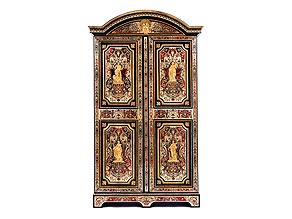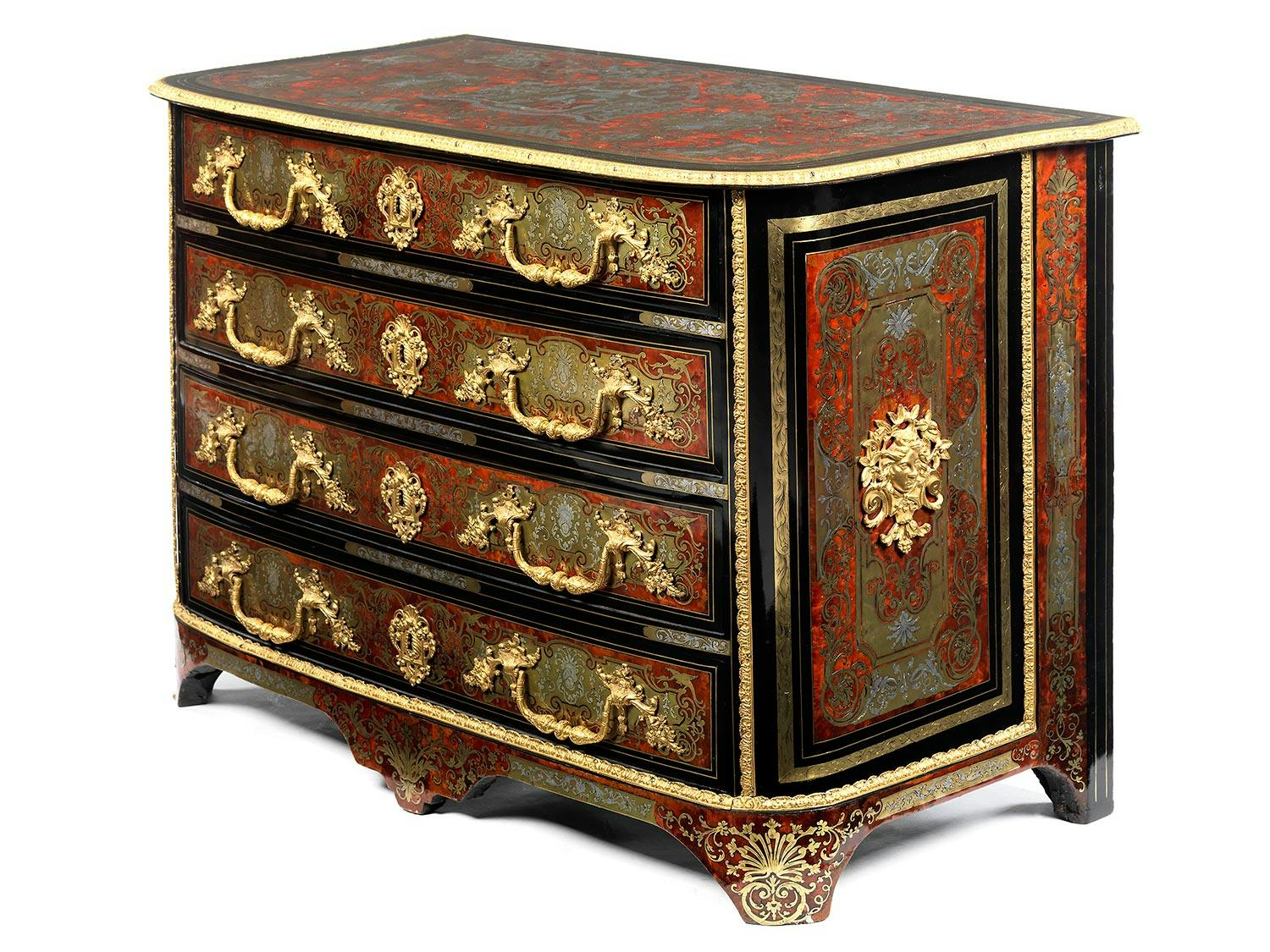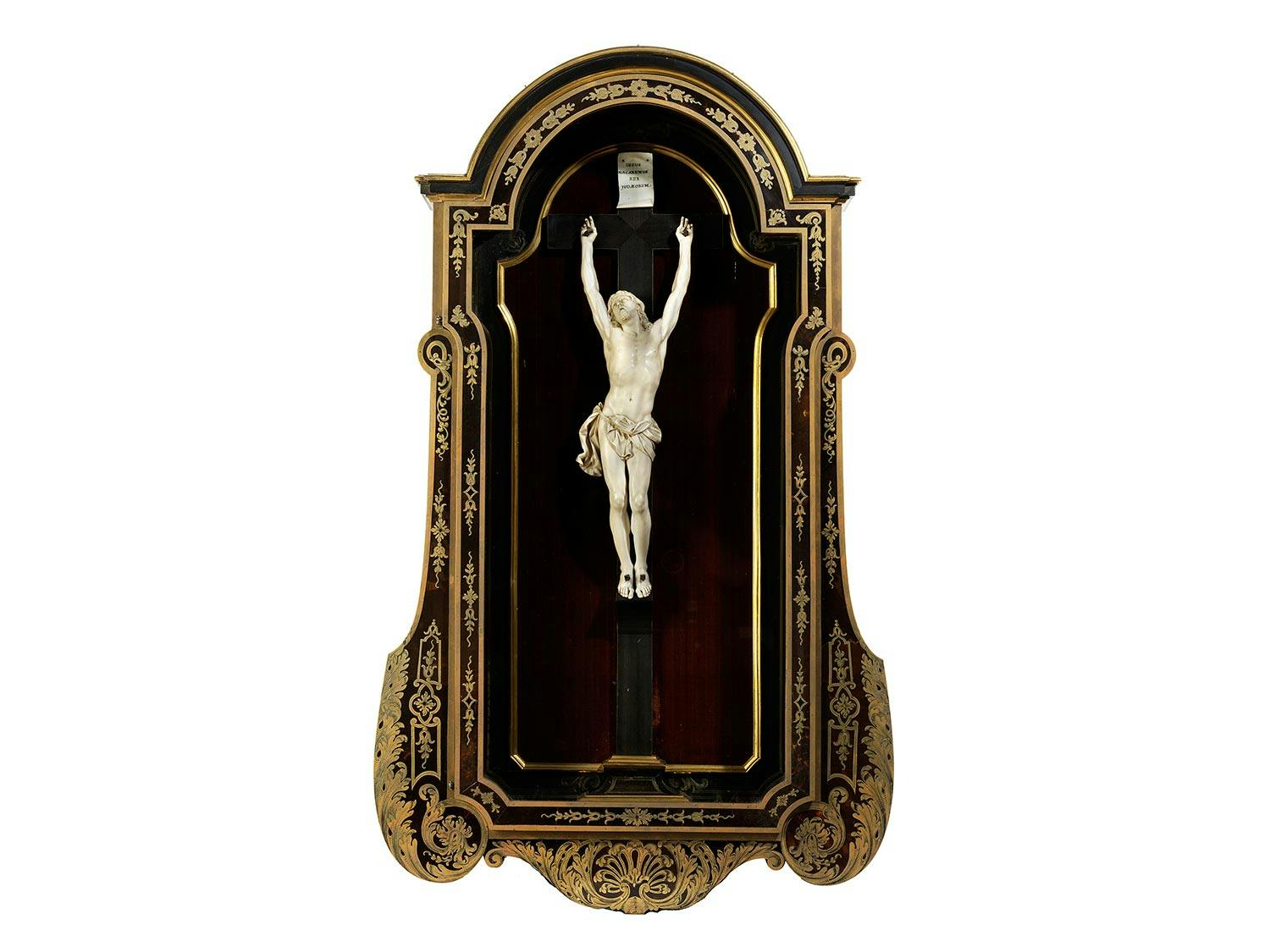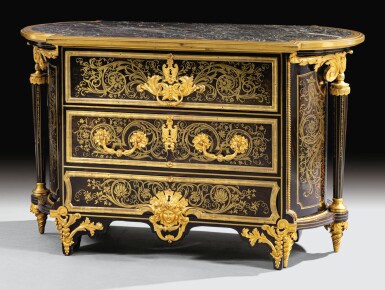An important Louis XIV ormolu mounted ebony, fruitwood, sycamore, boxwood and bone inlaid floral marquetry large bureauMost probably by Renaud or Aubertin Gaudron, circa 1690-1700
The black embossed leather writing surface enclosed by a profusely inlaid border including grotesque masks, birds, flowers and insects above a central frieze drawer flanked by four drawers with conforming inlay and with bone florettes flanking the ormolu escutcheons, and opposing dummy drawers on eight cabriole legs and gilt bronze cloven hoof sabots, the sides inlaid with floral filled baskets, sold together with the book, Chefs d'Oeuvre des Marqueteurs by Pierre Ramond which discusses the bureau plat in great detail, 180cm wide x 80.5cm deep x 78.5cm high, (70.5in wide x 31 1/2in deep x 30 1/2in high)FootnotesProvenance
Galerie G. Sarti, Paris;
Salomon Stodel, Amsterdam.
Literature
Pierre Ramond, Chefs d'Oeuvre des Marqueteurs, Des Origines à Louis XIV, Paris, 1994, where written up over 3 pages (p.23-25).
J.N.Ronfort and J.D.Augarde, Paris, 9 November 1994, Très Exceptionnel Bureau en Marqueterie de Fleurs
Aubertin and Renaud Gaudron
Renaud Gaudron, Menuisier Ebéniste Ordinaire du Roi is the son of Aubertin Gaudron, Maître Menuisier Ebéniste who was working most probably for Philippe, duc d'Orléans, brother of Louis XIV and active from circa 1641.
Talented and successful, Renaud Gaudron inherited a flourishing business in 1691. A few years before, in 1686, Renaud Gaudron had already taken over from the deceased Pierre Golle as one of the main suppliers of the Garde-Meuble de la Couronne. In order to fulfil the demand, he was assisted by his brother, Nicolas (Gaudron le Jeune) who was Menuisier-Ebéniste in Versailles, and had a successful workshop.
As a contemporary of André-Charles Boulle producing similar marquetry pieces, Aubertin Gaudron (active circa 1670-1700) is intrinsically linked to him in the production of marquetry furniture. Both cabinet-makers were inspired by the rich Dutch floral designs of artists such as Jean-Baptiste Monnoyer and Nicolas Beaudesson, of which André-Charles Boulle owned many studies of flowers and birds.
According to a comprehensive study of the present lot by J.N.Ronfort and J.D.Augarde, the authors interestingly mention that Renaud Gaudron would have delivered 28 different floral marquetry pieces of furniture to the Garde-Meuble de la Couronne between 1688 and 1713. This comprised various types of tables, bureaux, commodes and guéridons.
Marqueterie de Fleurs au Naturel
It is under the influence of Flemish artists that floral marquetry gradually became the most important decorative style used on furniture during the first half of the 17th century. The initiators of this pictorial art were both Pierre Golle and Léonard van der Vinne in Florence. André-Charles Boulle, established in the galeries du Louvre from 1672 soon became the most sought artist of his time.
An interesting description of a marquetry commode delivered by Gaudron for the Château de Compiègne relates closely to the present one, described as: 'marqueterie de bois de plusieurs couleurs fond d'ébène orné au milieu d'un vase rempli de fleurs pose sur un bout de table et un masque grotesque au-dessous, le reste rempli de rinceaux, fleurs, oiseaux et papillons au naturel' (AN 01/3308). The grotesque masks can also be seen on a similar commode in the Musée des Arts Décoratifs in Paris (CLUNY 11762), as well as on another commode possibly by Gaudron, sold at Bonhams, London, 9 July 2015, lot 26 (£52,500 inc. premium).
The small contrasting inlays flanking the escutcheons of the present lot can also be found on a commode from the Wildenstein Collection, sold at Christie's, London, 14-15 December 2005, lot 115 (£84,000 inc. premium).
For an illustrative comparison of a late Louis XIV floral marquetry and ebony commode, see P. Kjellberg, Le Meuble Français et Européen du Moyen Age à nos jours, Paris 1991, p 92.
'Bureau à travailler'
The term 'bureau' as we interpret it today appears only a few years after the beginning of Louis XIV's reign. Before that, the term applied equally to what we now refer to as commodes. For example, the celebrated commodes which André-Charles Boulle delivered to Louis XIV's bedroom at Trianon in 1708 (now in Versailles) were then called 'bureaux'. Gaudron delivered various commodes which he called 'grandes tables en bureau garnies de trois grands tiroirs' to the Garde-Meuble de la Couronne in 1695, 1697 and 1698.
The bureaux as we conceive them today were first described in the 1670s. The celebrated cabinet maker Pierre Gole delivered 'un bureau en cabinet d'ébène à fleurs et pièces de bois de rapport' on 4 February 1671. Another bureau of closely related form with eight legs, was delivered by the cabinet maker Michel Campe in 1674 as per its description in the Journal du Garde-Meuble. It is described as being veneered in floral marquetry against an ebony ground.
Our bureau 'à caissons' is particularly important due to its very large size for the period. Only very few similar bureaux at that time measure between 'cinq et six pieds de long' (162 to 194cm).
The bone inlay has been examined by Dickie Zebregs from Zebregs&Röell Fine Art and Antiques who has confirmed it is bone and not ivory.
An important Louis XIV ormolu mounted ebony, fruitwood, sycamore, boxwood and bone inlaid floral marquetry large bureauMost probably by Renaud or Aubertin Gaudron, circa 1690-1700
The black embossed leather writing surface enclosed by a profusely inlaid border including grotesque masks, birds, flowers and insects above a central frieze drawer flanked by four drawers with conforming inlay and with bone florettes flanking the ormolu escutcheons, and opposing dummy drawers on eight cabriole legs and gilt bronze cloven hoof sabots, the sides inlaid with floral filled baskets, sold together with the book, Chefs d'Oeuvre des Marqueteurs by Pierre Ramond which discusses the bureau plat in great detail, 180cm wide x 80.5cm deep x 78.5cm high, (70.5in wide x 31 1/2in deep x 30 1/2in high)FootnotesProvenance
Galerie G. Sarti, Paris;
Salomon Stodel, Amsterdam.
Literature
Pierre Ramond, Chefs d'Oeuvre des Marqueteurs, Des Origines à Louis XIV, Paris, 1994, where written up over 3 pages (p.23-25).
J.N.Ronfort and J.D.Augarde, Paris, 9 November 1994, Très Exceptionnel Bureau en Marqueterie de Fleurs
Aubertin and Renaud Gaudron
Renaud Gaudron, Menuisier Ebéniste Ordinaire du Roi is the son of Aubertin Gaudron, Maître Menuisier Ebéniste who was working most probably for Philippe, duc d'Orléans, brother of Louis XIV and active from circa 1641.
Talented and successful, Renaud Gaudron inherited a flourishing business in 1691. A few years before, in 1686, Renaud Gaudron had already taken over from the deceased Pierre Golle as one of the main suppliers of the Garde-Meuble de la Couronne. In order to fulfil the demand, he was assisted by his brother, Nicolas (Gaudron le Jeune) who was Menuisier-Ebéniste in Versailles, and had a successful workshop.
As a contemporary of André-Charles Boulle producing similar marquetry pieces, Aubertin Gaudron (active circa 1670-1700) is intrinsically linked to him in the production of marquetry furniture. Both cabinet-makers were inspired by the rich Dutch floral designs of artists such as Jean-Baptiste Monnoyer and Nicolas Beaudesson, of which André-Charles Boulle owned many studies of flowers and birds.
According to a comprehensive study of the present lot by J.N.Ronfort and J.D.Augarde, the authors interestingly mention that Renaud Gaudron would have delivered 28 different floral marquetry pieces of furniture to the Garde-Meuble de la Couronne between 1688 and 1713. This comprised various types of tables, bureaux, commodes and guéridons.
Marqueterie de Fleurs au Naturel
It is under the influence of Flemish artists that floral marquetry gradually became the most important decorative style used on furniture during the first half of the 17th century. The initiators of this pictorial art were both Pierre Golle and Léonard van der Vinne in Florence. André-Charles Boulle, established in the galeries du Louvre from 1672 soon became the most sought artist of his time.
An interesting description of a marquetry commode delivered by Gaudron for the Château de Compiègne relates closely to the present one, described as: 'marqueterie de bois de plusieurs couleurs fond d'ébène orné au milieu d'un vase rempli de fleurs pose sur un bout de table et un masque grotesque au-dessous, le reste rempli de rinceaux, fleurs, oiseaux et papillons au naturel' (AN 01/3308). The grotesque masks can also be seen on a similar commode in the Musée des Arts Décoratifs in Paris (CLUNY 11762), as well as on another commode possibly by Gaudron, sold at Bonhams, London, 9 July 2015, lot 26 (£52,500 inc. premium).
The small contrasting inlays flanking the escutcheons of the present lot can also be found on a commode from the Wildenstein Collection, sold at Christie's, London, 14-15 December 2005, lot 115 (£84,000 inc. premium).
For an illustrative comparison of a late Louis XIV floral marquetry and ebony commode, see P. Kjellberg, Le Meuble Français et Européen du Moyen Age à nos jours, Paris 1991, p 92.
'Bureau à travailler'
The term 'bureau' as we interpret it today appears only a few years after the beginning of Louis XIV's reign. Before that, the term applied equally to what we now refer to as commodes. For example, the celebrated commodes which André-Charles Boulle delivered to Louis XIV's bedroom at Trianon in 1708 (now in Versailles) were then called 'bureaux'. Gaudron delivered various commodes which he called 'grandes tables en bureau garnies de trois grands tiroirs' to the Garde-Meuble de la Couronne in 1695, 1697 and 1698.
The bureaux as we conceive them today were first described in the 1670s. The celebrated cabinet maker Pierre Gole delivered 'un bureau en cabinet d'ébène à fleurs et pièces de bois de rapport' on 4 February 1671. Another bureau of closely related form with eight legs, was delivered by the cabinet maker Michel Campe in 1674 as per its description in the Journal du Garde-Meuble. It is described as being veneered in floral marquetry against an ebony ground.
Our bureau 'à caissons' is particularly important due to its very large size for the period. Only very few similar bureaux at that time measure between 'cinq et six pieds de long' (162 to 194cm).
The bone inlay has been examined by Dickie Zebregs from Zebregs&Röell Fine Art and Antiques who has confirmed it is bone and not ivory.









.jpg)



Testen Sie LotSearch und seine Premium-Features 7 Tage - ohne Kosten!
Lassen Sie sich automatisch über neue Objekte in kommenden Auktionen benachrichtigen.
Suchauftrag anlegen